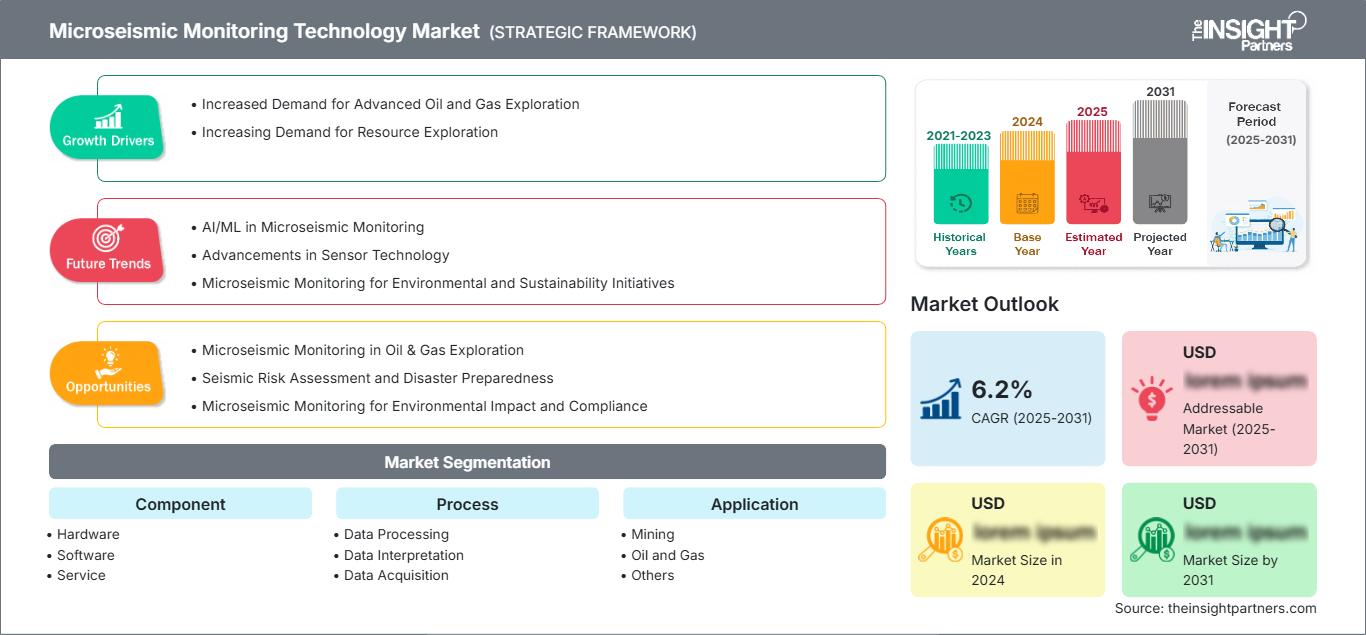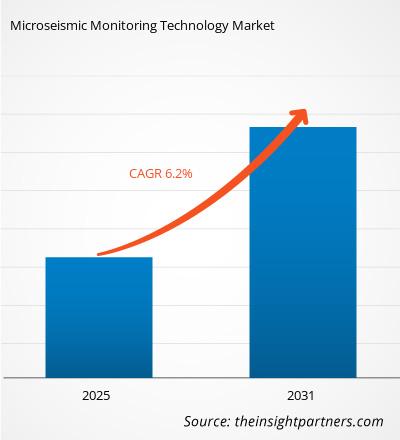Der Markt für mikroseismische Überwachungstechnologie wird voraussichtlich zwischen 2025 und 2031 eine durchschnittliche jährliche Wachstumsrate (CAGR) von 6,2 % verzeichnen, wobei die Marktgröße von XX Millionen US-Dollar im Jahr 2024 auf XX Millionen US-Dollar im Jahr 2031 anwachsen wird.
Der Bericht zum Markt für mikroseismische Überwachungstechnologie umfasst die Analyse nach Komponenten (Hardware, Software, Service), Prozessen (Datenverarbeitung, Dateninterpretation, Datenerfassung), Anwendung (Bergbau, Öl und Gas, Sonstige) und Geografie (Nordamerika, Europa, Asien-Pazifik sowie Süd- und Mittelamerika)
Zweck des Berichts
Der Bericht „Markt für mikroseismische Überwachungstechnologie“ von The Insight Partners beschreibt die aktuelle Situation und das zukünftige Wachstum sowie die wichtigsten treibenden Faktoren, Herausforderungen und Chancen. Dadurch erhält er Einblicke für verschiedene Geschäftsinteressenten, wie z. B.:
- Technologieanbieter/-hersteller: Um die sich entwickelnde Marktdynamik zu verstehen und die potenziellen Wachstumschancen zu erkennen, damit sie fundierte strategische Entscheidungen treffen können.
- Investoren: Um eine umfassende Trendanalyse hinsichtlich der Marktwachstumsrate, der finanziellen Marktprognosen und der Chancen entlang der Wertschöpfungskette durchzuführen.
- Regulierungsbehörden: Um Richtlinien und Überwachungsaktivitäten auf dem Markt zu regulieren, mit dem Ziel, Missbrauch zu minimieren, das Vertrauen der Investoren zu wahren und die Integrität und Stabilität des Marktes aufrechtzuerhalten.
Komponente zur Marktsegmentierung für mikroseismische Überwachungstechnologie
- Hardware
- Software
- Service
Prozess
- Datenverarbeitung
- Dateninterpretation
- Datenerfassung
Anwendung
- Bergbau
- Öl und Gas
- Sonstige
Geographie
- Nordamerika
- Europa
- Asien-Pazifik
- Süd- und Mittelamerika
- Naher Osten und Afrika
Sie erhalten kostenlos Anpassungen an jedem Bericht, einschließlich Teilen dieses Berichts oder einer Analyse auf Länderebene, eines Excel-Datenpakets sowie tolle Angebote und Rabatte für Start-ups und Universitäten.
Markt für mikroseismische Überwachungstechnologie: Strategische Einblicke

-
Holen Sie sich die wichtigsten Markttrends aus diesem Bericht.Dieses KOSTENLOSE Beispiel umfasst Datenanalysen, die von Markttrends bis hin zu Schätzungen und Prognosen reichen.
Wachstumstreiber für mikroseismische Überwachungstechnologie
- Steigende Nachfrage nach fortschrittlicher Öl- und Gasexploration: Die verbesserte Förderung von Kohlenwasserstoffen aus bestehenden und neuen Lagerstätten im Energiesektor verbessert die mikroseismische Überwachungstechnologie durch die Weiterentwicklung von Explorations- und Produktionstechniken. Die Technologie liefert dringend benötigte Informationen über das Verhalten von unterirdischen Strukturen und das Verhalten des Reservoirs und ermöglicht Unternehmen, ihre Bohrstrategien sowie die mit dem Explorationsprozess verbundenen Risiken zu optimieren.
- Steigende Nachfrage nach Ressourcenexploration: Einer der Hauptfaktoren für den Markt für mikroseismische Überwachungstechnologie ist die steigende Nachfrage nach Ressourcenexploration, insbesondere in der Öl-, Gas- und Mineraliengewinnung. Da Unternehmen in zunehmend anspruchsvollen Umgebungen wie Tiefsee-, Schiefergas- oder unkonventionellen Lagerstätten unerforschte Reserven erschließen, ist mikroseismische Überwachung von größter Bedeutung, da sie Einblicke in das Geschehen unter der Oberfläche ermöglicht. Die Technologie stellt sicher, dass Risse erkannt, das Verhalten des Reservoirs überwacht und eine sichere Ressourcenförderung gewährleistet wird. Es hilft bei der Optimierung von Bohrvorgängen, der Verbesserung der Ressourcenrückgewinnung und der Vermeidung kostspieliger Pannen, indem es Echtzeitdaten zu seismischen Ereignissen liefert. Da ein anhaltender Bedarf an Ressourcenexploration und effizienten Extraktionstechniken besteht, gewinnt die mikroseismische Überwachungstechnologie an Bedeutung und treibt so das Wachstum des Marktes voran.
Markttrends für mikroseismische Überwachungstechnologie: Zukünftige Trends im Markt für mikroseismische Überwachungstechnologie
- KI/ML in der mikroseismischen Überwachung: Der Markt für mikroseismische Überwachungstechnologie wird umfangreiche KI/ML für eine effizientere Datenanalyse und -interpretation umfassen. Die Echtzeitverarbeitung großer Datenmengen im mikroseismischen Frontend ermöglicht eine genauere Erkennung und Charakterisierung von Untergrundaktivitäten, einschließlich der Überwachung von Reservoirs oder Verwerfungen. KI/ML-Algorithmen im Ressourcenmanagement und in der Risikobewertung werden Muster und Anomalien identifizieren und so eine bessere Entscheidungsfindung ermöglichen.
- Fortschritte in der Sensortechnologie: Zu den zukünftigen Trends zählen auch hochtechnologische Fortschritte in der Sensortechnologie, die mikroseismische Überwachungssysteme mit empfindlicheren, kompakteren und kostengünstigeren mikroseismischen Sensoren ausstatten werden. Fortschritte bei Glasfasersensoren und drahtlosen Netzwerken ermöglichen die Echtzeitüberwachung mikroseismischer Ereignisse über immer größere Gebiete. Dies wird die Produktion natürlicher Ressourcen und geothermischer Energie sowie die Überwachung seismischer Aktivitäten erweitern und zu einer allgemeinen Steigerung der Effektivität und Effizienz mikroseismischer Überwachungssysteme führen.
- Mikroseismische Überwachung für Umwelt- und Nachhaltigkeitsinitiativen: Die Anwendungsmöglichkeiten mikroseismischer Überwachungstechnologien werden über die aktuelle Öl- und Gasexploration hinausgehen und angesichts des wachsenden Umweltbewusstseins auch Umweltüberwachung und Nachhaltigkeitsinitiativen umfassen. Dies würde die Anwendung mikroseismischer Techniken zur Bewertung der Auswirkungen von Aktivitäten wie hydraulischem Aufbrechen, unterirdischer Kohlenstoffspeicherung und Bergbau auf die Umgebung beinhalten.
Marktchancen für mikroseismische Überwachungstechnologie
- Mikroseismische Überwachung in der Öl- und Gasexploration: Mikroseismische Überwachungstechnologie liefert Untergrundbilder und Echtzeitdaten und verbessert so den Explorations- und Produktionsprozess im Öl- und Gassektor. Die Unternehmen entwickeln fortschrittliche mikroseismische Überwachungslösungen, um das Verhalten von Reservoirs, das Risswachstum und die Ressourcenrückgewinnung genauer abschätzen zu können.
- Seismische Risikobewertung und Katastrophenvorsorge: Im Hinblick auf die seismische Risikobewertung und Katastrophenvorsorge besteht eine erhöhte Nachfrage nach mikroseismischen Überwachungstechnologien. Diese technologischen Werkzeuge werden die wahrscheinlichen seismischen Gefahren identifizieren und den Gemeinden folglich dabei helfen, bessere Bereitschaftspläne und Minderungsstrategien zu formulieren. Unternehmen, die sich auf mikroseismische Überwachungslösungen für Städte und Regionen mit hohem Erdbebenrisiko spezialisieren, profitieren von staatlichen und privaten Investitionen in die Infrastruktur und die öffentliche Sicherheit.
- Mikroseismische Überwachung für Umweltverträglichkeit und Compliance: Da der Nachhaltigkeitsdruck auf die Industrie steigt, wird die Technologie der mikroseismischen Überwachung im Bereich Umweltüberwachung und Umweltverträglichkeitsprüfung Abnehmer finden. Da Bergbau und Geothermie mit der Abfallentsorgung verbunden sind, die unterirdisch ablaufen, können Unternehmen durch ihre Überwachungskapazitäten Maßnahmen zur Einhaltung der Vorschriften ergreifen und ökologische Störungen minimieren.
Regionale Einblicke in den Markt für mikroseismische Überwachungstechnologie
Die Analysten von The Insight Partners haben die regionalen Trends und Faktoren, die den Markt für mikroseismische Überwachungstechnologie im Prognosezeitraum beeinflussen, ausführlich erläutert. In diesem Abschnitt werden auch die Marktsegmente und die geografische Lage in Nordamerika, Europa, dem asiatisch-pazifischen Raum, dem Nahen Osten und Afrika sowie Süd- und Mittelamerika erörtert.
Umfang des Marktberichts zur mikroseismischen Überwachungstechnologie
| Berichtsattribut | Einzelheiten |
|---|---|
| Marktgröße in 2024 | US$ XX million |
| Marktgröße nach 2031 | US$ XX Million |
| Globale CAGR (2025 - 2031) | 6.2% |
| Historische Daten | 2021-2023 |
| Prognosezeitraum | 2025-2031 |
| Abgedeckte Segmente |
By Komponente
|
| Abgedeckte Regionen und Länder |
Nordamerika
|
| Marktführer und wichtige Unternehmensprofile |
|
Dichte der Marktteilnehmer im Bereich der mikroseismischen Überwachungstechnologie: Verständnis ihrer Auswirkungen auf die Geschäftsdynamik
Der Markt für mikroseismische Überwachungstechnologie wächst rasant. Dies wird durch die steigende Nachfrage der Endnutzer aufgrund veränderter Verbraucherpräferenzen, technologischer Fortschritte und eines stärkeren Bewusstseins für die Produktvorteile vorangetrieben. Mit der steigenden Nachfrage erweitern Unternehmen ihr Angebot, entwickeln Innovationen, um den Bedürfnissen der Verbraucher gerecht zu werden, und nutzen neue Trends, was das Marktwachstum weiter ankurbelt.

- Holen Sie sich die Markt für mikroseismische Überwachungstechnologie Übersicht der wichtigsten Akteure
Wichtige Verkaufsargumente
- Umfassende Abdeckung: Der Bericht analysiert umfassend Produkte, Dienstleistungen, Typen und Endnutzer des Marktes für mikroseismische Überwachungstechnologie und bietet einen ganzheitlichen Überblick.
- Expertenanalyse: Der Bericht basiert auf dem umfassenden Verständnis von Branchenexperten und Analysten.
- Aktuelle Informationen: Der Bericht gewährleistet Geschäftsrelevanz durch die Berichterstattung über aktuelle Informationen und Datentrends.
- Anpassungsoptionen: Dieser Bericht kann an spezifische Kundenanforderungen angepasst werden und passt sich optimal an die Geschäftsstrategien an.
Der Forschungsbericht zum Markt für mikroseismische Überwachungstechnologie kann daher dazu beitragen, die Branchensituation und die Wachstumsaussichten zu entschlüsseln und zu verstehen. Obwohl es einige berechtigte Bedenken geben mag, überwiegen die Vorteile dieses Berichts tendenziell die Nachteile.
- Historische Analyse (2 Jahre), Basisjahr, Prognose (7 Jahre) mit CAGR
- PEST- und SWOT-Analyse
- Marktgröße Wert/Volumen – Global, Regional, Land
- Branchen- und Wettbewerbslandschaft
- Excel-Datensatz
Aktuelle Berichte
Erfahrungsberichte
Grund zum Kauf
- Fundierte Entscheidungsfindung
- Marktdynamik verstehen
- Wettbewerbsanalyse
- Kundeneinblicke
- Marktprognosen
- Risikominimierung
- Strategische Planung
- Investitionsbegründung
- Identifizierung neuer Märkte
- Verbesserung von Marketingstrategien
- Steigerung der Betriebseffizienz
- Anpassung an regulatorische Trends






















 Kostenlose Probe anfordern für - Markt für mikroseismische Überwachungstechnologie
Kostenlose Probe anfordern für - Markt für mikroseismische Überwachungstechnologie